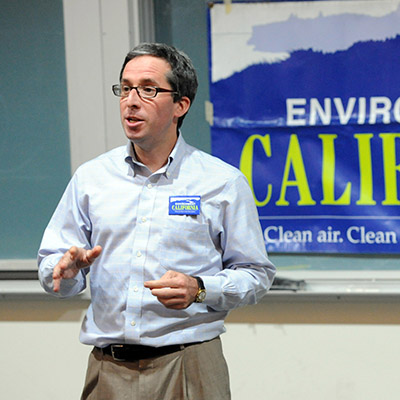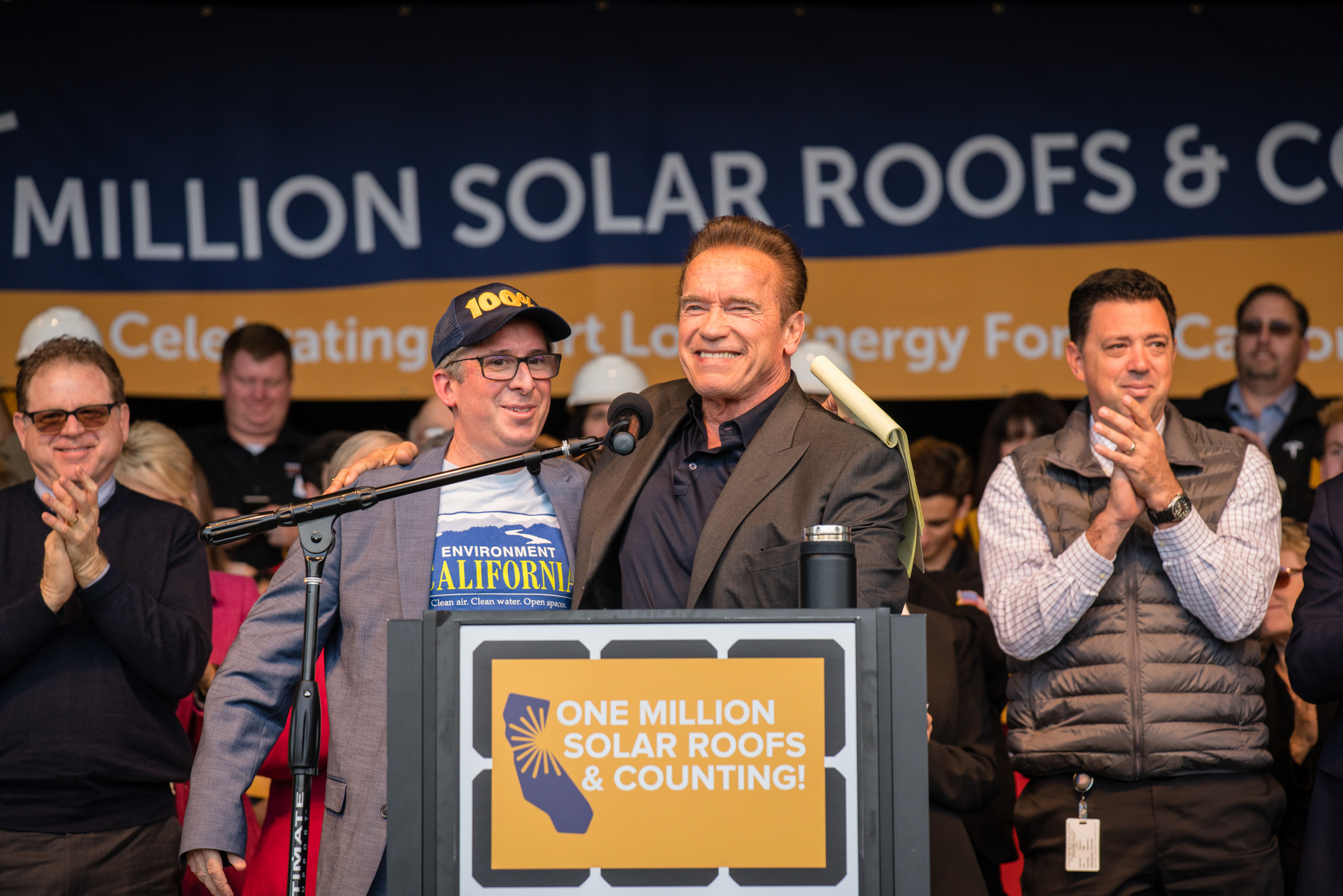
Three lessons from California’s Million Solar Roofs milestone
In 2019, California committed to the goals of the original 2005 unamended Million Solar Roofs vision, mandating solar on all new homes starting Jan. 1, 2020.

Environment California director Dan Jacobson shares a moment with former Gov. Arnold Schwarzenegger during an event celebrating the state’s millionth solar installation. Photo: Tomas Ovalle.
They said California couldn’t build a million solar roofs.
But the skeptics were wrong. And that’s good, not only because the Million Solar Roofs initiative grew our solar power, but also because it created momentum for new goals to repower our state and the nation with renewable energy.
Back in 2005, we had already been through an energy crisis and rolling blackouts. Giant wildfires were still in our future, but we knew that solar power was a valuable part of the equation to combat the challenges of a changing world. At the time, a skimpy 20,000 solar installations existed statewide, meeting only a tiny portion of California’s energy needs.
That didn’t make sense to state Sen. Kevin Murray of Los Angeles, who introduced a bill calling for one million solar roofs on homes, businesses, farms and schools. The goal was to help homeowners move toward energy independence, lower their electric bills, and make a smart move toward a better future.
The original bill required the installation of solar panels on every new home. But builders opposed it, thinking Californians wouldn’t want to buy new houses if they were forced to absorb the additional upfront cost of solar panels. So the bill was amended to create a ten-year, $3 billion declining rebate program to entice homeowners and small businesses to go solar, with a goal of installing 3,000 megawatts of solar capacity (enough to power one million homes).
Even with those amendments, the bill still faced opposition. But Gov. Arnold Schwarzenegger’s commitment to the goal was matched by champions in the legislature like state Sen. Sam Blakesley and Assemblymember Fran Pavley, and by strong public support in communities across the state. In 2006, the bill became law.
Thirteen years later, we’ve surpassed our original goal almost three times over, with 8,700 megawatts of solar installed, but at no additional cost to the state beyond the original rebate program.
The state rebate helped bring down the upfront cost of installing solar, drawing more customers into the market. That encouraged more skill specialization and technological development all along the supply chain, bringing down the price of rooftop solar itself, from $9.45 per watt in 2006 to $3.80 per watt in 2018.
In 2019, California committed to the goals of the original 2005 unamended Million Solar Roofs vision, mandating solar on all new homes starting Jan. 1, 2020.
This story offers three lessons.
First, never underestimate the power of unexpected alliances. An unlikely cast of characters — a Democratic state senator from inner-city Los Angeles, a Hollywood Republican governor and some scrappy activists — set the stage for what’s now a milestone in our nation’s energy transition.
Second, never write off anyone as a potential ally. The builders who opposed the original bill in 2005 ultimately became big supporters of the program to create the 2019 solar mandate — because after ten years of implementing the voluntary program, they got used to solar.
Third, goal-setting works. Whether it’s a team reaching the World Series or astronauts landing on the moon, a goal attaches a big idea to a delivery date, and gets everyone working together. Case in point: Of the 30 states that have set mandatory renewable power targets for their electricity mix, 25 of them have since raised their goals — most because they figured out that they were going to hit their goals early. Commitment to a goal leads to technological improvement, then prices coming down, then greater use of the technology. This virtuous cycle is generating more solar power every day.
We’re going to keep hearing that it can’t be done. So we need to go right on working with all the allies we can find, setting goals, and pushing toward a clean energy future.
Authors
Dan Jacobson
Senior Advisor, Environment California
Dan provides campaign strategy and policy guidance for Environment California's program and organizational plans. Prior to his current role, he worked as the state director of Environment California and the organizing director of Florida PIRG, among other roles. The Center for Energy Efficiency and Renewable Technologies (CEERT) named Dan a Clean Power Champion in 2019, and Capitol Weekly named him one of the “Top 100 Lobbyists” in California in 2008. Dan's areas of expertise include renewable energy, electric vehicles and ocean pollution, and he has successfully advocated for the passage of dozens of bills into law, including measures to ban toxic chemicals, bring 1 million solar roofs to California, and ban single-use plastic grocery bags. He ran the campaign for SB 100, California’s law setting a goal of 100 percent clean energy by 2045.

